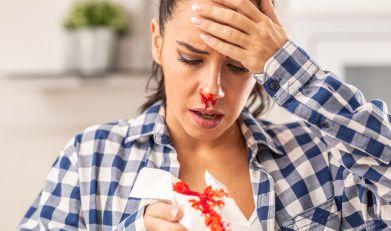What is Nose bleeding?
Nose bleeding, also known as Epistaxis, occurs when blood vessels in the nose rupture and bleed. Simply put, a nosebleed is the loss of blood from the tissue that lines the inside of your nose. This can be caused by a variety of factors, including dry air, nasal irritation or injury, high altitude, medication side effects, and underlying medical conditions such as high blood pressure or blood clotting disorders. Nosebleeds can range from mild to severe and may occur in one or both nostrils. While most nosebleeds are not serious and can be treated at home, it is important to seek medical attention if the bleeding is heavy or accompanied by other symptoms such as dizziness or difficulty breathing.
What causes nose bleeding?
Nosebleeds, or epistaxis, can be caused by a variety of factors. Here are some common causes of nosebleeds:-
- Dry air:- Dry air can irritate and dry out the nasal passages, causing them to become inflamed and more prone to bleeding.
- Nasal irritation:- Nasal irritation from allergies, dust, smoke, or chemical irritants can also cause the blood vessels in the nose to become inflamed and bleed.
- Trauma:- Trauma to the nose from injury, such as a blow to the face or nose picking, can cause the blood vessels in the nose to rupture and bleed.
- Medical conditions:- Certain medical conditions, such as high blood pressure, blood clotting disorders, or liver disease, can increase the risk of nosebleeds.
- Medications:- Certain medications, such as blood thinners, can increase the risk of nosebleeds.
- Other factors:- Other factors that may contribute to nosebleeds include high altitudes, nasal surgery, and tumors in the nasal cavity.
What can be done to cure of nose bleeding?
Here are some steps you can take to treat nosebleeds at home:-
- Pinch the nostrils:- Pinch your nostrils together with your thumb and forefinger and breathe through your mouth for 5 to 10 minutes. This will help to apply pressure to the bleeding vessel and stop the bleeding.
- Lean forward:- Tilt your head slightly forward to prevent the blood from flowing down the back of your throat.
- Apply ice:- Apply a cold compress, such as a bag of ice or a towel soaked in cold water, to your nose and cheeks. This will help to constrict the blood vessels and reduce the bleeding.
- Stay hydrated:- Drink plenty of fluids to keep your nasal passages moist and prevent dryness.
- Avoid blowing your nose:- Avoid blowing your nose for several hours after a nosebleed to prevent further irritation.
- Keep your nasal passages moisturized:- Dryness and irritation in the nasal passages can make you more susceptible to nosebleeds. Use a saline nasal spray or apply a small amount of petroleum jelly to the inside of your nostrils to keep them moist.
- Avoid picking your nose:- Picking your nose can irritate the lining of your nostrils and increase the risk of nosebleeds. If you feel the urge to clear your nostrils, gently blow your nose instead of picking.
- Avoid irritants:- Exposure to irritants such as smoke, chemicals, or dust can irritate the lining of your nostrils and increase the risk of nosebleeds. Avoid exposure to these irritants as much as possible.
- Elevate your head while sleeping:- Elevating your head while sleeping can help reduce the pressure on the blood vessels in your nose and prevent nosebleeds.
What are the risk factors of nose bleeding?
Some of the risk factors associated with nosebleeds include:-
- Dry air:- Dry air can cause the inside lining of the nose to become dry and irritated, increasing the risk of nosebleeds.
- Trauma:- Any kind of injury or trauma to the nose, such as a fall or a blow to the face, can increase the risk of nosebleeds.
- Age:- Nosebleeds are more common in children and older adults.
- Certain medications:- Certain medications, such as blood thinners, can increase the risk of nosebleeds.
- Medical conditions:- Medical conditions such as high blood pressure, liver disease, and blood clotting disorders can increase the risk of nosebleeds.
- Chemical irritants:- Exposure to certain chemicals, such as household cleaning products or industrial chemicals, can irritate the inside lining of the nose and increase the risk of nosebleeds.
Are there different kinds of nosebleeding?
Yes, there are different types of nosebleeding, and they are classified based on the location of the bleeding within the nose.
- Anterior nosebleeds:- Anterior nosebleeds are the most common type of nosebleed and occur when the bleeding originates from the blood vessels in the front part of the nose, known as the nasal septum. These nosebleeds usually start suddenly and are often easy to control.
- Posterior nosebleeds:- Posterior nosebleeds occur when the bleeding originates from the blood vessels at the back of the nose, near the throat. These nosebleeds can be more serious and difficult to control, and may require medical attention.
- Traumatic nosebleeds:- Traumatic nosebleeds occur as a result of injury or trauma to the nose, such as a blow to the nose or picking the nose. These nosebleeds can be either anterior or posterior, and may require medical attention depending on the severity of the injury.
- Spontaneous nosebleeds:- Spontaneous nosebleeds occur without any apparent cause, and can be either anterior or posterior. These nosebleeds may be a sign of an underlying medical condition and should be evaluated by a healthcare professional.
Dhanwantri Pharmaceutical recommends Kamal Madhu syrup because it is an Ayurvedic medicine that contains natural ingredients, including Gulab Pushp, Rakt Chandan, Brahmi, and Carrot. It is also used in India for the treatment of nosebleeding, blood circulation etc.

